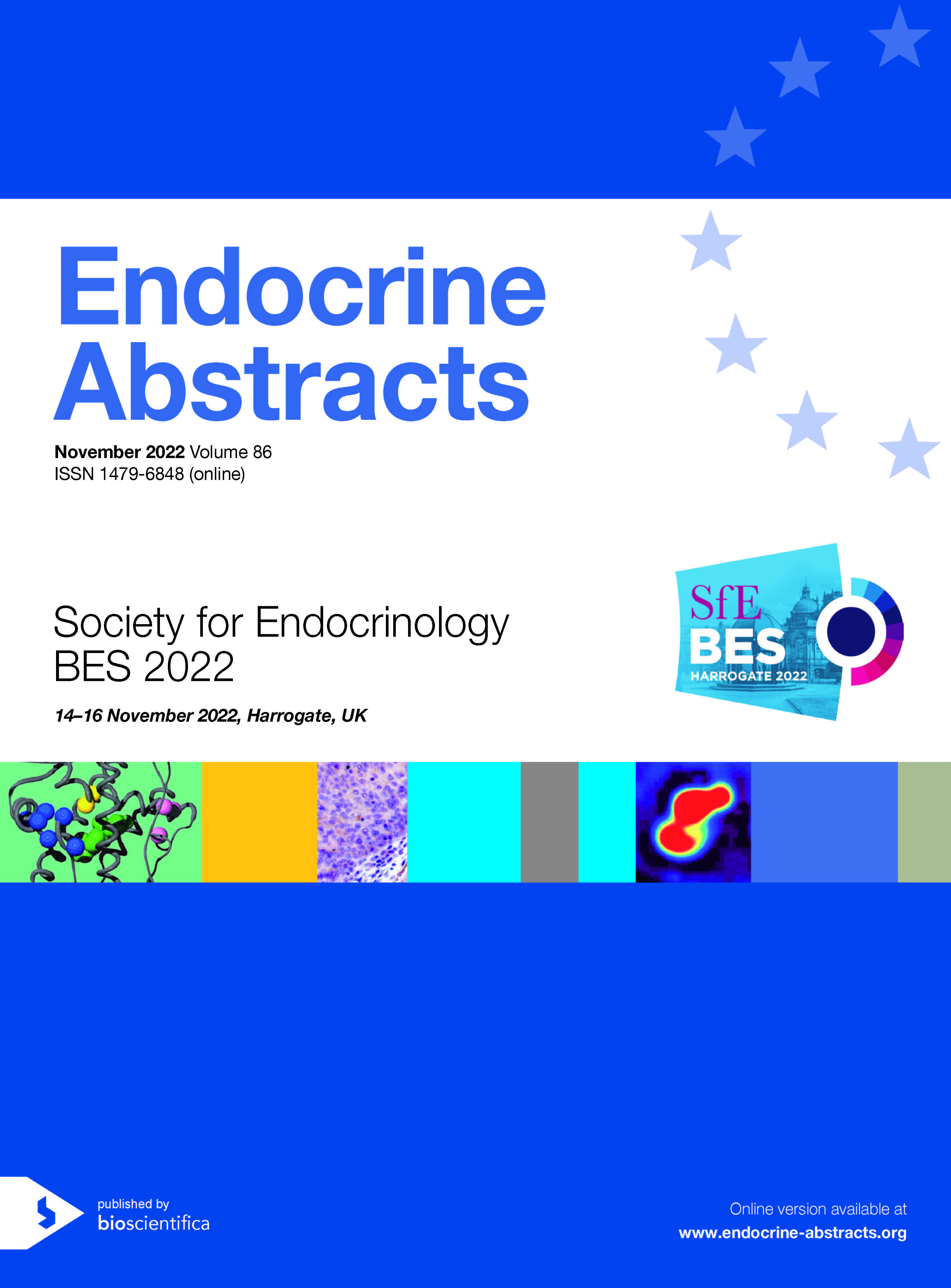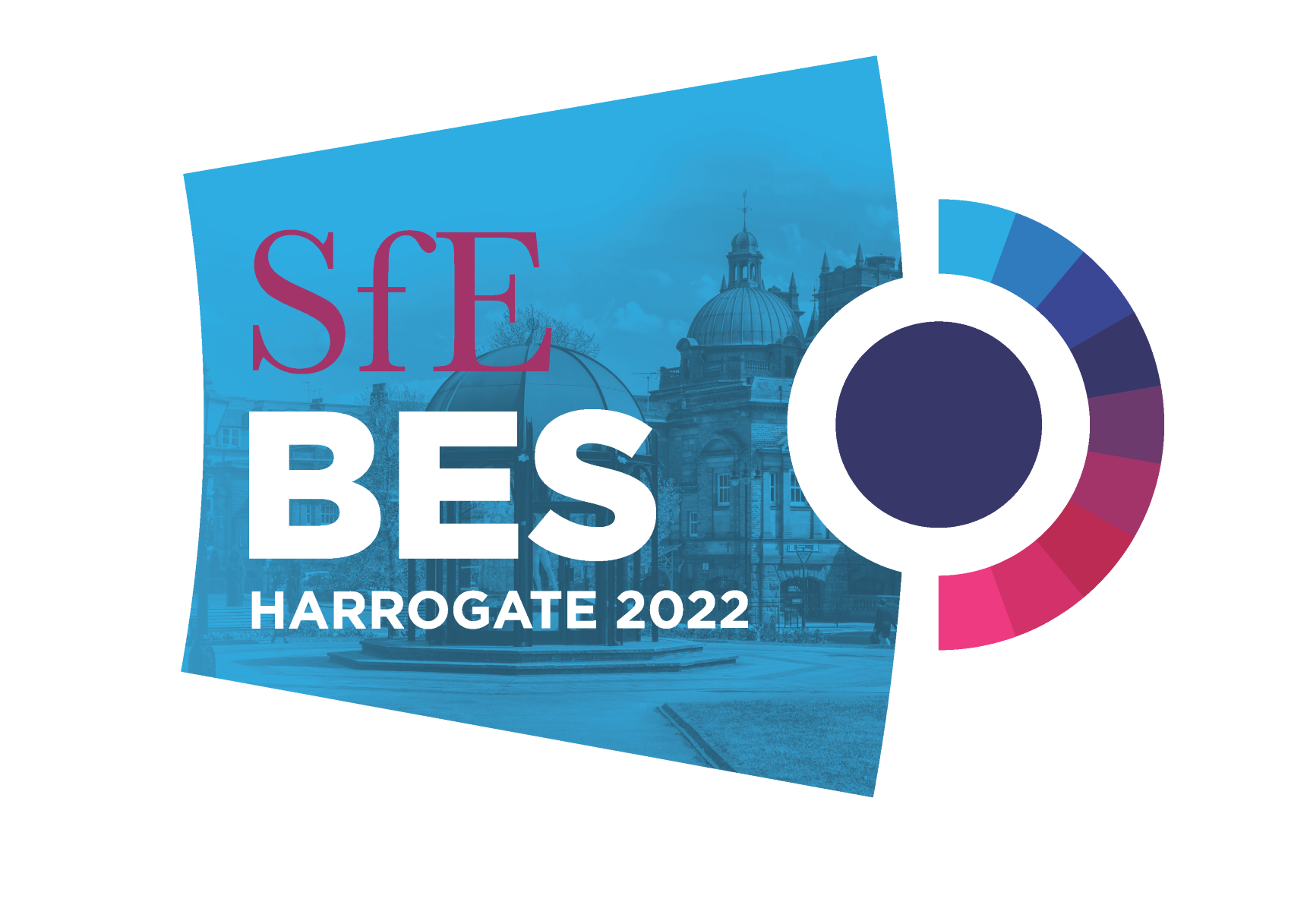
Society for Endocrinology BES 2022
Harrogate,
United Kingdom
14 Nov 2022 - 16 Nov 2022

Poster Presentations
Thyroid
ea0086p131 | Thyroid | SFEBES2022
Therapeutic database of anti-thyroid medication over 10 years in northern ireland (NI) 2010-2019: trends, demographics and deprivation
Kayes Lucy , McHenry Claire , Woodside Jayne , Mullan Karen
ea0086p132 | Thyroid | SFEBES2022
Reconsidering the role of thyroidectomy in thyroid eye disease (TED) patients
Sipkova Zuzana , Keren Shay , David Joel , Mihai Radu , Turner Helen , Norris Jonathan
ea0086p133 | Thyroid | SFEBES2022
Comparison of supervised rapid thyroxine absorption test in refractory and well-controlled primary hypothyroid patients in a tertiary care center in Sri Lanka and formulation of a prediction model to predict the expected FT4 rise during the test
G K Amiyangoda C , Antonypillai C N , Gunatilake S S C G , Ediriweera D , Kosgollana S G P D , Jayawardena R D P , Thissera H A N D , Emalka W J , Deraniyagala H U
ea0086p134 | Thyroid | SFEBES2022
High TRAB at the Time of Radio-iodine therapy (RAIT) Predicts Persistent Hyperthyroidism
George Arun , Kumar Kalaria Tejas , Buch Harit N
ea0086p135 | Thyroid | SFEBES2022
Thyroid function testing in people treated with Lithium: We are doing more thyroid tests than is necessary
Duce Helen , Duff Christopher J , Syed Zaidi , Parfitt Ceri , Fryer Anthony , Heald Adrian
ea0086p136 | Thyroid | SFEBES2022
Evaluation of Prevalence and Causes of Thyroid dysfunction in Hospitalized Patients
ea0086p137 | Thyroid | SFEBES2022
Treatment-refractory hypothyroidism probably secondary to concurrent phenytoin administration
P Than Yu Kyi , Oyibo Samson O , Sagi Satyanarayana V , Rajkanna Jeyanthy
ea0086p138 | Thyroid | SFEBES2022
Antithyroid Arthritis syndrome: A rare side effect
Shaikh Sheeba , Komlosy Nicci , Gibson Christine , Lewis Alexander
ea0086p139 | Thyroid | SFEBES2022
A rare case of Hashimoto’s encephalopathy
Bakhtawar Khawaja , Akunuri Mani
ea0086p140 | Thyroid | SFEBES2022
Review of Nottingham University Hospital Antenatal Thyroid Service for Patients with Autoimmune Hyperthyroidism
Whitehurst Katharine , Nisal Kaustubh
ea0086p141 | Thyroid | SFEBES2022
Are we following NICE guidelines in classifying hyperthyroid patients presenting to endocrinology clinic in a DGH?
Khalil Ghayyur , Ahsan Masato , Johnson Adam , Smurthwaite Hannah , Mani Hamidreza
ea0086p142 | Thyroid | SFEBES2022
Thyroid storm triggered by RSV pneumonia
ea0086p143 | Thyroid | SFEBES2022
A delayed diagnosis of Graves’ disease in a patent with severe hyperthyroidism-associated hypercalcaemia
Ramzan Adil , Sagi Satyanarayana V , Oyibo Samson O
ea0086p144 | Thyroid | SFEBES2022
Human chorionic gonadotropin (hCG) mediated thyrotoxicosis secondary to metastatic choriocarcinoma
ea0086p145 | Thyroid | SFEBES2022
Iodine-based contrast media-induced hyperthyroidism in a patient with underlying subclinical hyperthyroidism and multinodular goitre
P Than Yu Kyi , Htun Kyaw Z , Sagi Satyanarayana V , Rajkanna Jayanthy , Oyibo Samson O
ea0086p146 | Thyroid | SFEBES2022
Three times unlucky or a unifying endocrine diagnosis?
Malik Muhammad , Kazmi Rashid , Narayanan Srinivasan , Bujanova Jana
ea0086p147 | Thyroid | SFEBES2022
An Unusual Presentation of An Autoimmune thyroid Disease
Alkaabi Fatima , Ismail Mohammed
ea0086p280 | Thyroid | SFEBES2022
Novel targets determination among patients with angioinvasive differentiated thyroid cancer
Buczyńska Angelika , Sidorkiewicz Iwona , Kościuszko Maria , Adamska Agnieszka , Siewko Katarzyna , Zbucka-Krętowska Monika , Jacek Krętowski Adam , Popławska-Kita Anna
ea0086p281 | Thyroid | SFEBES2022
The potential interaction between medical treatment and radioiodine treatment success: a systematic review
Zannat Riazul , Lee Jonathan , Muzaffar Jameel , Read Martin L. , Brookes Katie , Sharma Neil , Boelaert Kristien , McCabe Christopher J. , Nieto Hannah T.
ea0086p282 | Thyroid | SFEBES2022
The future of TSH receptor antibody (TRAb) testing at university hospitals birmingham (UHB)
Milner Imogen , Kennedy Louis , Rahim Asad
ea0086p283 | Thyroid | SFEBES2022
Abnormalities of thyroid function tests in patients receiving Immune Checkpoint Inhibitor Treatment for Cancer; importance of a wide-angled lens
D S A Dilrukshi M , Anguelova L , Morovat A , Turner H E
ea0086p284 | Thyroid | SFEBES2022
The Barnet Thyrotoxicosis Pathway – A Quality Improvement Project
North Matthew , Kurani Amit , Katz Jonathan
ea0086p285 | Thyroid | SFEBES2022
Preoperative Rapid Optimisation in poorly controlled Graves’ disease: An outpatient experience during the COVID-19 pandemic
Shaan Goonoo Mohummad , Fahad Arshad Muhammad , Hussein Ziad , Balasubramanian Sabapathy
ea0086p286 | Thyroid | SFEBES2022
Graves’ thyrotoxicosis and spontaneous coronary artery dissection: Is there a link?
Mulla Kaenat , Avari Parizad , Freudenthal Bernard , Cox Jeremy
ea0086p287 | Thyroid | SFEBES2022
Primary MALT lymphoma of thyroid with hypothyroidism and absence of Hashimoto’s disease
Tellier Genevieve , Wood Ffion , Searell Catrin , Barwick Catrin , Wilton Anthony
ea0086p288 | Thyroid | SFEBES2022
Arterial Thrombus in a Graves thyrotoxicosis - Hyper-coagulable state and Hyperthyroidism
Uchambally Manjima , Pernicova Ida
ea0086p289 | Thyroid | SFEBES2022
Graves’ disease with benign ethnic neutropenia-a grave combination
Minhas Raisa , Shekhda Kalyan , Palan Jessal , Vogazianou Artemis , Richards Huw , McMillan Annabel
ea0086p290 | Thyroid | SFEBES2022
Late relapse of thyroid eye disease (TED)
Murphy Noel , Oustabassidis Eva , David Joel , Norris Jonathan H , Turner Helen E
ea0086p291 | Thyroid | SFEBES2022
Clinical case of Alemtuzumab induced thyroid storm requiring urgent inpatient thyroidectomy
Akbar Shahzad , Sharma Tanisha , Gopalappa Jagannath , Jayagopal Vijay
ea0086p292 | Thyroid | SFEBES2022
Thyroid Storm presenting without fever
Iqbal Khan Irfan , Tahir Chohan Muhammad , Ahmad Waqar , Ali Zainab , De Los Angeles Maillo-Nieto Maria
ea0086p293 | Thyroid | SFEBES2022
Pfizer vaccine induced subacute thyroiditis
Khalid Maha , Sivappryian Siva , Malik Mohammed
ea0086p294 | Thyroid | SFEBES2022
A Challenging Case of Oscillating Hashimoto’s thyroiditis and Hyperthyroidism
Aye Thant Aye , Glover Amy , Banerjee Moulinath
ea0086p295 | Thyroid | SFEBES2022
Radioactive Iodine treatment (RAI) for benign thyroid disease: ESHT outcomes
Mizanour Rahman Md , Ravelo Maria , Gupta Sheena , Salt Chris , Sathis Kumar P
ea0086p296 | Thyroid | SFEBES2022
Euthyroidism: following a course of radio iodine therapy for Graves’ disease
Aransiola Clement , Olamoyegun Michael , Ifedayo Odedina
ea0086p297 | Thyroid | SFEBES2022
A rare case of agranulocytosis secondary to carbimazole medication complicated by a prolonged COVID-19 infection
Bottoms Nicole , Ward Lisa , Banerjee Ritwik , Thong Lim Chung
ea0086p364 | Thyroid | SFEBES2022
Evaluating the progression to hypothyroidism in preconception euthyroid thyroid-peroxidase antibody positive women
Dhillon-Smith Rima , Gill Sofia , Cheed Versha , Boelaert Kristien , Chan Shiao , Coomarasamy Arri
ea0086p365 | Thyroid | SFEBES2022
A rise in the incidence of Graves’ disease in North West Wales during the COVID-19 pandemic: an effect of the SARS-CoV-2 virus or vaccine?
Tellier Genevieve , Wood Ffion , Searell Catrin , Wilton Anthony
ea0086p366 | Thyroid | SFEBES2022
Use of Burch-Wartofsky score when assessing the severity of hyperthyroidism, a retrospective study
Vennard Hannah , Duvieusart Ysaline , McNeilly Jane , Kernohan Andrew
ea0086p367 | Thyroid | SFEBES2022
L-T3 Prescribing & Deprescribing - Single Centre Experience
Day Katie , Swe Myint Khin , Neupane Sankalpa , Swords Frankie , Ahluwalia Rupa
ea0086p368 | Thyroid | SFEBES2022
Falsely elevated serum TSH in a mother and her four children
Darrat Milad , Shah Shilpa , Halsall David , Schoenmakers Nadia , Bradley Una
ea0086p369 | Thyroid | SFEBES2022
A rare case of profound refractory hypothyroidism: Compliance or Formulation issue?
Htet Aung Htet , Radia Florika , Kong Chantal



